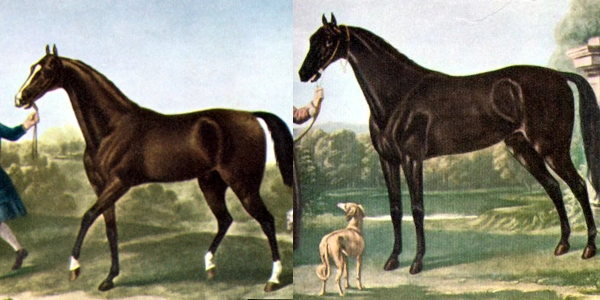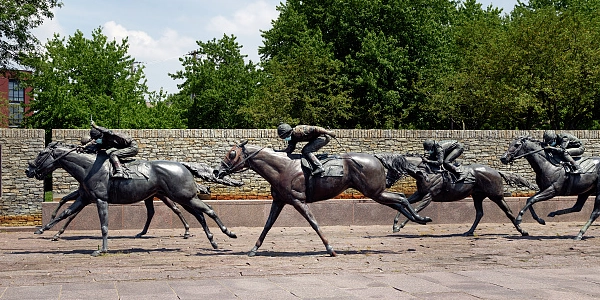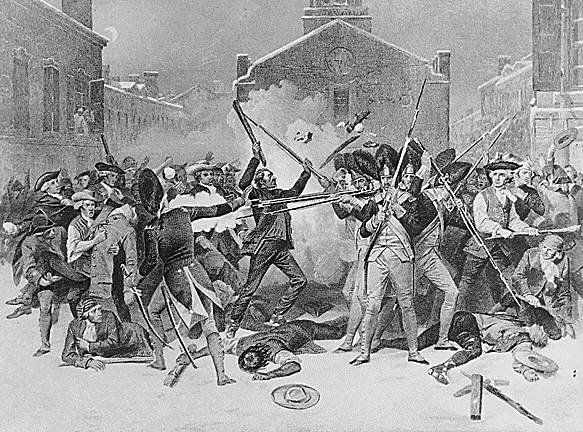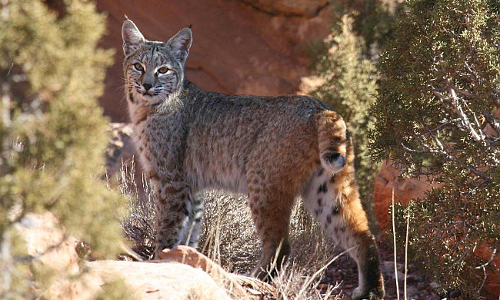
Photo above: Betsy Ross sewing the first American flag in Philadelphia. Courtesy National Archives. Right: Lithograph of the Boston Tea Party. Courtesy Library of Congress.

Sponsor this page for $75 per year. Your banner or text ad can fill the space above.
Click here to Sponsor the page and how to reserve your ad.
-
Timeline
1778 Detail
In an advertisement in a Kentucky gazette, a New Jersey stallion gains the name thoroughbred, the first usage in the United States of that equine term.

Well, first we'll talk a little about the history of the horse in Kentucky, even though this, apparently first mention of the term in the United States was about a New Jersey stallion. For Kentucky, European horses was introduced into the territory by Daniel Boone, who brought pack horses into the area on a hunting trip in 1769. They were soon stolen by the Indians. As settlers began to make the trip through the Cumberland Gap to settle Harrodsburg, 1774, and Boonesboro, 1775, they came by foot or horseback. A wagon road would not be established until 1795.
But the frontiersmen in Kentucky were quickly enamored by racing horses, establishing a racecourse in Harrodsburg one year after it was established. Called Shallowford, part of the course was the road to Boonesboro. By 1780, the first circular racecourse was established in Lincoln County by William Whitley, who had moved there from Virginia. He insisted the races were run counterclockwise, just to hiss off the English, who ran their races clockwise.
But in between this time of the first Kentucky racetracks, there was a newspaper called the Kentucky Gazette, apparently not the famous one started in 1787, that spoke of horse racing and breeding. There is even a marker on William Whitley Road, as well as others surrounding the Whitley house in Lincoln County, that tells of the story of horse racing in Kentucky, although most of this is post the first advertisement mentioning the thoroughbred.
Most racing at the time was done by quarter horses. So to use the term "thoroughbred" in an advertisement was very unusual, particularly for the time period. Its etymology is listed as starting, first used, in 1796, to mean "pure breed of stock." It was used as an adjective. Use as a noun did not occur until 1842.
More History of Kentucky Racing
So let's worry less about when the term was first used, but how it became synonymous with Kentucky horse racing even before the Kentucky Derby was born. In the Lexington area, horse racing was also gaining traction. By the 1790 Fayette County tax rolls, there were nine thousand six hundred and seven horses and fifty-six stallions in the county. Racing was being done, at the start, as the settlement of an argument instead of using a dual. Starting in 1791, quarter horse racing down the streets of Lexington was an annual October three day custom.
The first known advertisement for Kentucky horse breeding was noted on February 16, 1788, three years earlier, when a quarter horse named Pilgarlick was put up for stud. One year later, the first racetrack for thoroughbreds was built in Lexington, and the October tradition now included a three mile race of which thoroughbreds, not quarter horses, were bred for. With additional racecourses being built in Kentucky through the end of the century, the need for thoroughbred breeding became an essential part of Kentucky's economy and history. Race courses for thoroughbreds were now in Georgetown, Danville, Bardstown, Shelbyville, Versailles, Winchester, and Maysville.

The Thoroughbred
Let's start with the definition. A thoroughbred, according to the Mirriam-Webster Dictionary today ... adjective "bred from the best blood through a long line," ... noun "any of an English breed of light speedy horses kept chiefly for racing that originated from crosses between English mares of uncertain ancestry and Arabian stallions."
So when did this all start. In 17th and 18th century England, breeding a horse for the skills of horse racing, high-blooded, spirited, and speedy, started with the use of English mares with Oriental stallions from Arabia, Barb, or Turkoman descent. Through the end of the 18th century, the Thoroughbred breed spread around the world, the first imports into the Americas about 1730.
But what may be the most interesting part of this somewhat convoluted tale is that there were three stallions who were the first studs and started the breed and all thoroughbreds trace back to them; the Byerley Turk (1680s), the Darley Arabian (1704), and the Godolphin Arabian (1729). That's kinda cool.
So it's a bit of a mystery why a United States thoroughbred being mentioned in 1778 was news-worthy or advertisement worthy, or even accurate, particularly as the American Revolution was being waged in the American colonies. Perhaps it was a diversion from the vagaries of war, or just the need for an economy that could feed a family during the struggle.
Image above: Paintings of two of the foundation sires of the Thoroughbred breed, (left) Darley Arabian, unknown date or author. (right) Byerley Turk, unknown date, John Wootten. Courtesy Wikipedia Commons. Image below: Sculptures of throughbreds reacing in Thoroughbred Park, Lexington, 2020, Carol M. Highsmith. Courtesy Library of Congress. Info Source: International Museum of the Horse; etymonline.com; Wikipedia Commons.

Back to Index
History Photo Bomb

But the frontiersmen in Kentucky were quickly enamored by racing horses, establishing a racecourse in Harrodsburg one year after it was established. Called Shallowford, part of the course was the road to Boonesboro. By 1780, the first circular racecourse was established in Lincoln County by William Whitley, who had moved there from Virginia. He insisted the races were run counterclockwise, just to hiss off the English, who ran their races clockwise.
But in between this time of the first Kentucky racetracks, there was a newspaper called the Kentucky Gazette, apparently not the famous one started in 1787, that spoke of horse racing and breeding. There is even a marker on William Whitley Road, as well as others surrounding the Whitley house in Lincoln County, that tells of the story of horse racing in Kentucky, although most of this is post the first advertisement mentioning the thoroughbred.
Most racing at the time was done by quarter horses. So to use the term "thoroughbred" in an advertisement was very unusual, particularly for the time period. Its etymology is listed as starting, first used, in 1796, to mean "pure breed of stock." It was used as an adjective. Use as a noun did not occur until 1842.
The first known advertisement for Kentucky horse breeding was noted on February 16, 1788, three years earlier, when a quarter horse named Pilgarlick was put up for stud. One year later, the first racetrack for thoroughbreds was built in Lexington, and the October tradition now included a three mile race of which thoroughbreds, not quarter horses, were bred for. With additional racecourses being built in Kentucky through the end of the century, the need for thoroughbred breeding became an essential part of Kentucky's economy and history. Race courses for thoroughbreds were now in Georgetown, Danville, Bardstown, Shelbyville, Versailles, Winchester, and Maysville.

So when did this all start. In 17th and 18th century England, breeding a horse for the skills of horse racing, high-blooded, spirited, and speedy, started with the use of English mares with Oriental stallions from Arabia, Barb, or Turkoman descent. Through the end of the 18th century, the Thoroughbred breed spread around the world, the first imports into the Americas about 1730.
But what may be the most interesting part of this somewhat convoluted tale is that there were three stallions who were the first studs and started the breed and all thoroughbreds trace back to them; the Byerley Turk (1680s), the Darley Arabian (1704), and the Godolphin Arabian (1729). That's kinda cool.
So it's a bit of a mystery why a United States thoroughbred being mentioned in 1778 was news-worthy or advertisement worthy, or even accurate, particularly as the American Revolution was being waged in the American colonies. Perhaps it was a diversion from the vagaries of war, or just the need for an economy that could feed a family during the struggle.
Image above: Paintings of two of the foundation sires of the Thoroughbred breed, (left) Darley Arabian, unknown date or author. (right) Byerley Turk, unknown date, John Wootten. Courtesy Wikipedia Commons. Image below: Sculptures of throughbreds reacing in Thoroughbred Park, Lexington, 2020, Carol M. Highsmith. Courtesy Library of Congress. Info Source: International Museum of the Horse; etymonline.com; Wikipedia Commons.

Back to Index





